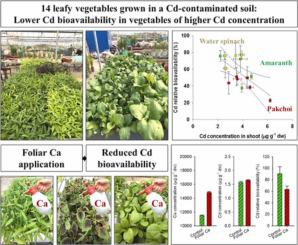Journal of Hazardous Materials ( IF 12.2 ) Pub Date : 2021-09-28 , DOI: 10.1016/j.jhazmat.2021.127373 Meng-Yu Wang 1 , Meng-Ya Li 1 , Han Ning 1 , Rong-Yue Xue 1 , Jia-Hui Liang 1 , Ning Wang 2 , Xiao-San Luo 3 , Gang Li 4 , Albert L Juhasz 5 , Lena Q Ma 6 , Hong-Bo Li 1

|
To test high cadmium (Cd) concentration may not be high in health risk when considering Cd bioavailability, we assessed variation of Cd relative bioavailability (RBA, relative to CdCl2) using a mouse assay for 14 vegetables of water spinach, amaranth, and pakchoi. Cadmium concentration varied from 0.13±0.01 to 0.37±0.00 μg g–1 fw. Cadmium-RBA also varied significantly from 22.9±2.12 to 77.2±4.46%, however, the variation was overall opposite to that of Cd concentration, as indicated by a strong negative correlation between Cd-RBA and Cd concentration (R2=0.43). Based on both Cd concentration and bioavailability, the identified high-Cd pakchoi variety resulted in significantly lower Cd intake than the high-Cd varieties of water spinach and amaranth (4.74±0.05 vs. 10.1±0.54 and 8.03±0.04 μg kg–1 bw week–1) due to significantly lower Cd-RBA (22.9±2.12 vs. 77.2±4.46 and 51.3±2.93%). The lower Cd-RBA in pakchoi was due to its significantly higher Ca and lower phytate concentrations, which facilitated the role of Ca in inhibiting intestinal Cd absorption. This was ascertained by observation of decreased Cd-RBA (90.5±12.0% to 63.5±5.53%) for a water spinach when elevating its Ca concentration by 30% with foliar Ca application. Our results suggest that to assess food Cd risk, both total Cd and Cd bioavailability should be considered.
中文翻译:

镉的口服生物利用度受食物中钙和植酸盐含量的影响:来自小鼠叶菜的证据
为了在考虑 Cd 生物利用度时测试高镉 (Cd) 浓度对健康风险可能并不高,我们使用小鼠试验评估了 14 种空心菜、苋菜和小白菜蔬菜的Cd 相对生物利用度(RBA,相对于 CdCl 2 )的变化. 镉浓度从 0.13±0.01 到 0.37±0.00 μg g –1 fw 不等。Cd-RBA 也从 22.9±2.12 到 77.2±4.46% 显着变化,然而,变化总体上与 Cd 浓度相反,这表明 Cd-RBA 和 Cd 浓度之间存在强烈的负相关 ( R 2=0.43)。基于 Cd 浓度和生物利用度,与高 Cd 品种的空心菜和苋菜相比,所确定的高 Cd 小白菜品种的 Cd 摄入量显着降低(4.74±0.05 vs. 10.1±0.54 和 8.03±0.04 μg kg –1 bw第–1周),因为 Cd-RBA 显着降低(22.9±2.12 对 77.2±4.46 和 51.3±2.93%)。小白菜中较低的 Cd-RBA 是由于其显着较高的 Ca 和较低的植酸盐浓度,这促进了 Ca 在抑制肠道 Cd 吸收中的作用。这通过在叶面施用钙将其钙浓度提高 30% 时观察到菠菜的 Cd-RBA 降低(90.5±12.0% 至 63.5±5.53%)来确定。我们的结果表明,为了评估食物中的镉风险,应同时考虑总镉和镉的生物利用度。











































 京公网安备 11010802027423号
京公网安备 11010802027423号